Cooking demos, pop-up dinners and the Mexican in us Filipinos

The kitchen gods may have come and gone during last week’s Madrid Fusión Manila (MFM) 2016, but the gastronomic extravaganza continues throughout the archipelago until the end of April.
Touted as the “Flavors of the Philippines month,” it is the third component of MFM 2016 that will definitely place our country as the culinary destination of choice for this decade.
Set were market tours, gourmet fairs, food shows, a dinner with the stars, and cooking demonstrations. A must-see is the ongoing food exhibition at the Metropolitan Museum of Manila until July 16, entitled “Tapas: Spanish Design for Food,” presenting a historical overview of the marriage between food and the arts.
Come April 22, I’ll be doing a cooking demo of our iconic sisig to be held at the Museo Ning Angeles in my home city of Angeles, Pampanga.
On Sunday, April 24, I will do another cooking demo on how to make bringhé at the World Street Food Congress (WSFC) to be held at Bonifacio Global City.
At the opposite end of MFM culinary spectrum, the WSFC is a lowbrow gastronomic summit organized by KF Seetoh, founder of Makansutra, and the DOT. It will be forum between entrepreneurs and culinary ambassadors, showcasing delicious iconic street food from some 20 different countries. April is indeed a culinary milestone to mark.
Pop-Up Dinners
Originating from the US, pop-up dinners have been around for the past decade or so. It gives an opportunity to up-and-coming talented chefs (or just anybody who shares the same passion for food) of renting for a one-time event at a home, warehouse, kitchen, or dining space of an established restaurant (called the brick-and-mortar permanent building) and pre-selling tickets. It is the incubator/start-up for many a budding chef, just like the food truck, and might eventually lead to opening their own permanent “brick-and-mortar” joint.
Many of the visiting uber chefs during MFM 2016 did their own pop-up dinners, collaborating with local chefs in different establishments around the metropolis. The very limited five-figure seats were grabbed by local food aficionados weeks before the event. I was one of the lucky few to experience the cuisine of chef Dani Garcia (of his namesake restaurant in Marbella, Spain) held at the New World Manila Bay Hotel last April 4.
By the way, his executive chef is our kababayan, Santiago Guerrero, whom they failed to acknowledge both at the dinner and forum. To paraphrase an old hag expression, “For every successful chef is a very exhausted executive chef.”
Mission: Possible
If the pop-up event concept has been around for quite some time, it was only last week that I fully understood what it meant, or at least, I saw it formed like a growing balloon before my eyes.
Food writer Margaux Salcedo proposed I cook a pop-up dinner at a hotel to raise funds for the Kidapawan farmers, and it would be the first event of her newly formed advocacy group Mission: Manila, a project to promote Filipino chefs and Philippine cuisine.
On April 9 I cooked an intimate 10-course dinner for 16 paying guests, with the Raffles and Fairmont Hotels, Makati City, pitching in a function room and its service and kitchen staff for the event for free. It was their way of joining the DOT’s Flavors of the Philippines month. Olivia Limpe-Aw, the first female chair and fifth-generation owner of the 164-year-old Destileria Limtuaco and Artisan Cellars, pitched in their beverages as well.
I was given roughly three and a half days to prepare a 10-course dinner. It’s a good thing I’d already been toying with the Spanish-inspired tapas idea, using local ingredients and panlasa (taste) since last year’s MFM. I already had several dishes up my chef’s jacket sleeve, so to speak. This, coupled with our book Linamnam (co-authored with my wife, Mary Ann) with its treasure trove of culinary information, came in handy. Indeed, the mission was possible.
Everything But The Kitchen Sink
Going by the MFM 2016 theme “The Manila Galleon: East Meets West,” my being a Kapampangan came in very handy in composing the Raffles Hotel dinner. I didn’t have to search far and wide for inspiration. My own Pampango culinary roots reveals we have a lot more of Mexico than Spain in our veins, a direct result of the 250 years of the Galleon trade between Manila and Acapulco.
Just look at what’s cooking in a Pampango kitchen: tsokolate with maní (Mexican for peanuts, cacahuete in Spanish), a popular morning beverage wherein chocolate is mixed with ground peanuts together with carabao’s milk and sugar; tamales, a sort of rice pudding wrapped in banana leaf, flavored with maní and atsuete (Mexican achiote, English annatto; the Mexican tamal uses masa de maíz or lime-treated corn dough and wrapped in cornhusk;) champorado, a glutinous rice porridge mixed with chocolate, milk and sugar, and often eaten with tuyó or dried fish (from the Mexican champorrado, a chocolate-based warm and rich drink, thickened with masa de maíz.) And that’s just for breakfast.
Before I forget, among my collection of antique heirloom kitchen gadgets is a stone grinder in the shape of a rectangular downward curved slide, supported by a single foot on its high side (think of a stiletto). This was carved from a single piece of granite (perhaps made in China for the Mexican trade?). Anyway, it was only after seeing the movie Como Agua Para Chocolate (Like Water for Chocolate) that I learn what it was for. It’s called a metate, paired with a stone rolling pin to grind beans or seeds into paste.
The harmonious union of East and West is also evident in atsuete being widely used in dishes like kare-kare (maní-based beef stew believed of Indian origin yet using peanuts and atsuete from Mexico); pansit palabok/luglog made with rice noodles (Chinese origin;) pansit sotanghon or vermicelli noodles (Chinese); menudo, a pork stew named after the Mexican pig’s offal stew menudo; and lumpiang hubad or sautéed vegetables used as filling for the Chinese fresh spring roll, served with crushed maní.
Can you imagine having a pale kare-kare or palabok without the atsuete? Filipinos would be up in arms! Futhermore, the palabok is topped with crushed chicharon or pork crackling (from Mexican chicharron, known as corteza or torrezno in Spanish).
Our mother Imang During used to cook for us an heirloom dish called pata molé (from the Mexican molé or sauce), a tomato-based stew of pig’s trotters, chorizo, pimiento and paprika.
The regional lunches during the three-day MFM 2016 were themed into Almusal, Panlasa and Street Food. Panlasa explored the four basic tastes of sour, salty, sweet and bitter; combining any two or three together in any proportion would result in the linamnam factor — the yumminess or umami that defines our cuisine.
It is this play of panlasa that I always espoused as the hallmark of Filipino cooking, not like the spiciness of Indian cuisine (we hardly use spices like cumin, cardamom, cloves, curries, etc.) nor the heat from the chilies of Thai cuisine (though most Filipino males love the chilies, it is mostly added in the sawsawan or dipping sauces but hardly introduced into the cooking).
As a disclosure, 100 percent of the ingredients I used were sourced locally, with most of the vegetables and seafood bought at the Farmers Market in Cubao, Quezon City. For the three pork dishes, I used two organic suckling pigs from Reimon Gutierrez’s farm in Prado, Lubao, Pampanga. The organic salted duck egg yolk is from Itlog ni Kuya from Victoria, Laguna.
Some of the dishes served at the Mission: Manila dinner, their respective stories and the ‘panlasa’ profile
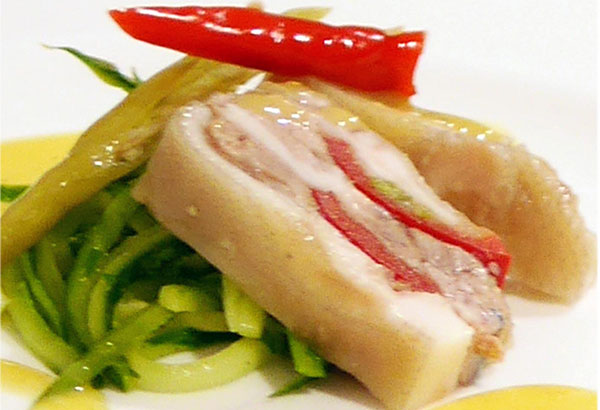
Sisig Terrine with cucumber strings, mango and dalandan vinaigrette (salty, sour, sweet, linamnam). Not known to many, the original Pampango sisig was a salad served with vinaigrette given to a pregnant woman (naglilihi or craving for something sour), as defined in a Kapampangan-Spanish dictionary written by Augustinian friar Diego Bergaño in 1732. But towards the last month of the pregnancy, the woman is given boiled pig’s ears, again dipped in vinegar (what is kilawin na baboy to the Tagalogs). It was only in the 1970s that a barbecue vendor named Aling Lucing Cunanan of Angeles City did a makeover by grilling further the pork parts and serving it with boiled chicken liver. My version of the sisig is a jellified terrine formed by the collagen of the piglet’s head parts boiled in pineapple juice.

Tuyom Rice Balls – Inspired by a traditional Tausug (people of Jolo) rice dish cooked in sea urchin shell and eaten with green mangoes and chilies (salty, sour, linamnam). Served on a bed of gusó seaweeds, cherry tomatoes, bagoong isda or anchovy vinaigrette spiked with Paradise Mango Rum liqueur.
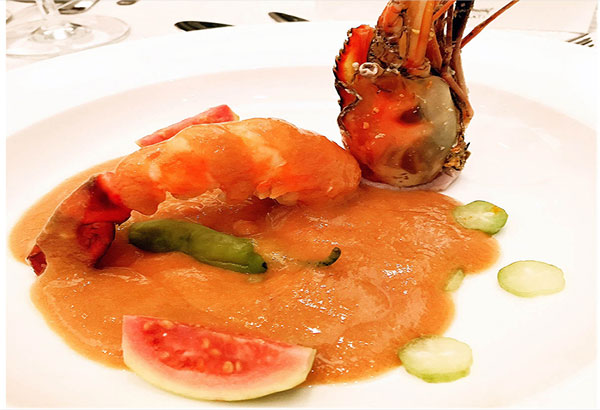
Guava Gazpacho – Chilled Pampango bulanglang or guava soup (called by the Tagalogs “sinigang sa bayabas”) with ulang or freshwater prawns caught from the wild along the Pampanga River (sweet, salty, sour, linamnam). Unknown to most Filipinos, what we call native guava originally came from Mexico, introduced by the Spanish friars during the Galleon trade, together with other fruits like avocado, sineguelas (Spanish plum), camachile, aratiles, watermelon, etc. When a foreign ingredient is used and adapted by the natives according to their panlasa, then it becomes theirs. With the searing daytime temperature, I was inspired by the Andalusian chilled soup gazpacho, as well as the chilled ulang taken a la shrimp cocktails.
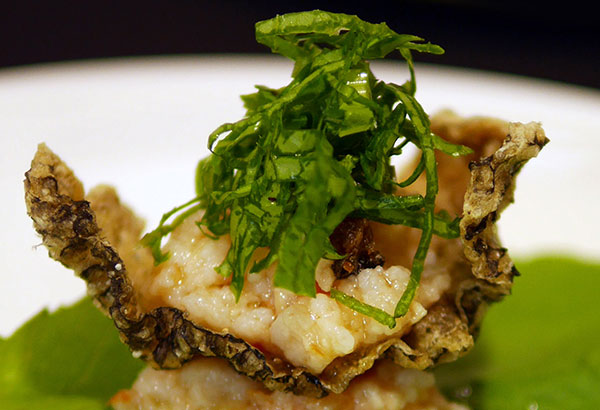
Fish-charon – If there’s a quintessential Pampango dish, this grouping is it. Fried or grilled freshwater fish (catfish, mudfish, tilapia or bangus) is eaten with burong hipon or fermented rice with shrimps and mustasa or fresh mustard leaves. For my tapas-inspired take I used a crisp tilapia skin chicharon shaped into a boat, filled with bits of fried catfish and burong hipon, and topped mustasa shreds.
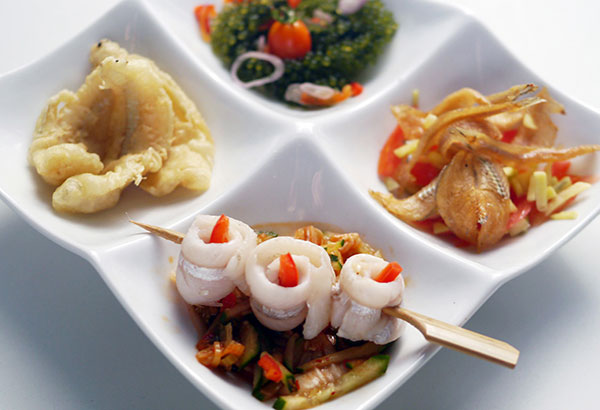
Tres Dilis-cias – If ever you find yourself eating in a Chinese restaurant in Madrid (it’s a last resort for Filipino travelers craving for a rice meal), chances are you’ll find in the menu the term “tres delicias” (arroz con tres delicias, pollo con tres delicias, gambas con tres delicias, etc.) It’s supposed to mean it has some three delicious ingredients, whatever they are. My take on this dish are the three different preparations of our of fresh dilis or anchovies: kinilaw (Spanish boquerones en vinagre), fried adobado (an Andalusian specialty of deep frying flour-coated, vinegar-marinated fish — think of daing na bangus), and sun-dried salted dilis served with lató seaweeds, green mango salad and atchara (salty, sour, sweet, linamnam with a spike of red chili from kimchi sauce).

Pork Choplets Adobo Confit with Ilocano dinardaraan and bilo-bilo or glutinous rice balls mimicking puto. Up north in the Ilocos region, their traditional sawsawan or dipping sauce for lechon and chicharon is dinardaraan/dinuguan or pork blood pudding cooked with vinegar. This is my take on the crispy dinuguan, first introduced by Dawang’s Place in San Nicolas, Ilocos Norte, several decades ago. For the crisp part, the mini pork chops were first marinated with an adobo mix overnight, then slow-cooked in fat a la French confit. Deep-fried last minute for that bagnet crisp (sour, salty, linamnam).
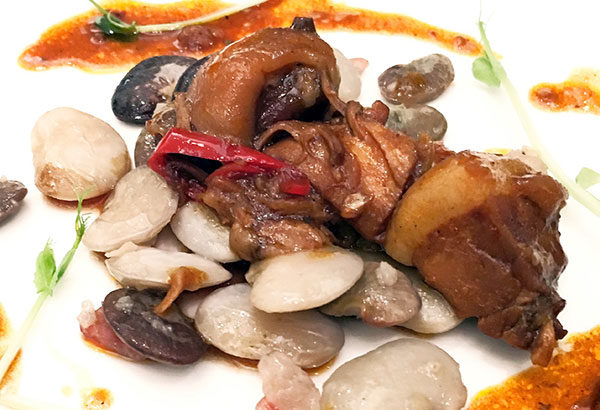
Pata-patita Molé – an heirloom Pampango tomato-based stew of suckling pig trotters, enhanced with smoked Guagua lingginita and served with sautéed patani or lima beans (salty, sour, sweet, bitter, linamnam). Could it be from the Mexican mole?
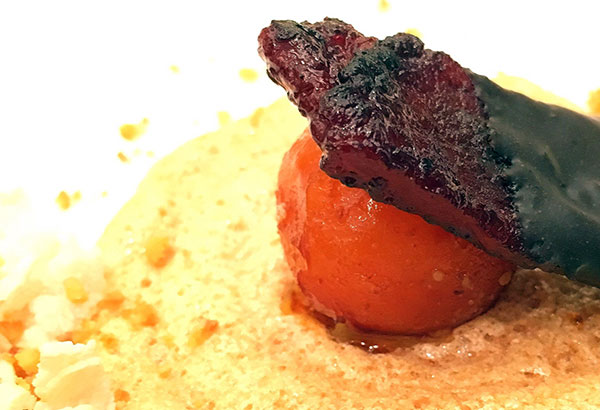
Sorpresa de Yema – Inspired by the theme Almusal, I used as a takeoff point our breakfast fare tosilog, an acronym for tocino (ham-like sweet cured pork), sinangag or garlic fried rice, and fried egg for dessert. I tasked my sister Doren Tayag (Upper Crust cakes) to make me four-inch meringue discs (actually single layers of sans rival) with a hole in the center to rest a whole salted duck egg (same as the Chinese moon cake). The salted yolks were slow-cooked overnight in a rice cooker on “warm” mode (who can afford the expensive sous vide machines, anyway) submerged in caramelized syrup with Magnolia butter and pandan leaf. This round meringue and egg yolk was supposed to mimic a fried sunny side-up egg, with popped pinipig (rice crispies) and crushed glazed pili nut and fried garlic rice, with a bar of dark chocolate (Nana Meng’s)-coated smoked tocino (fatless Pampanga’s Best). This dessert course was served with a mini squeeze bottle filled with a deep red color (sugar-beet reduction), salted caramel sauce to mimic banana ketchup (sweet, salty, bitter, linamnam, and a hint of pandan).



















